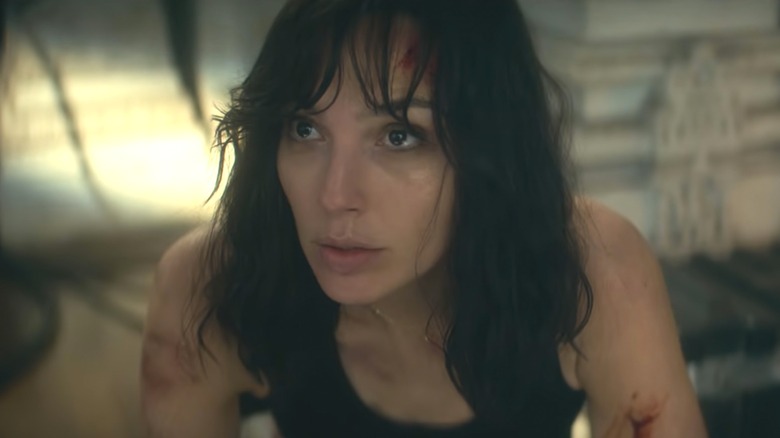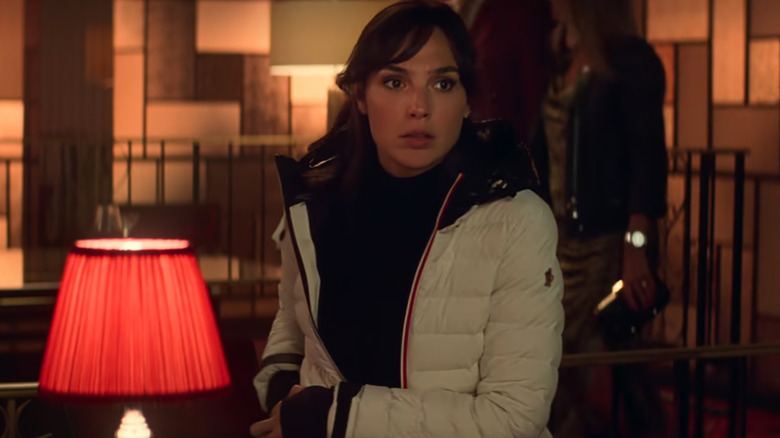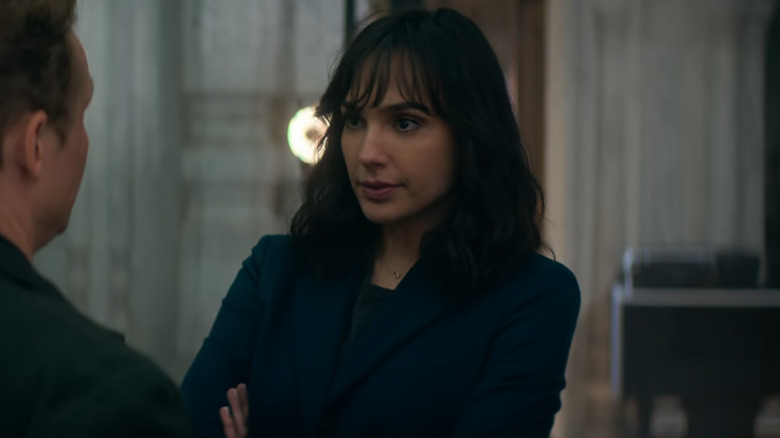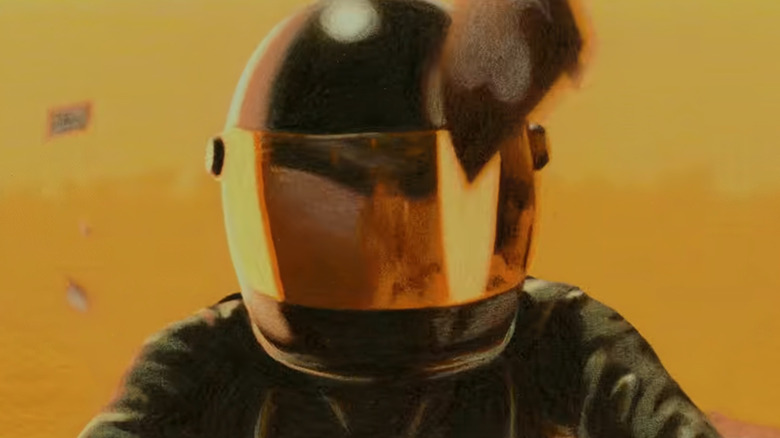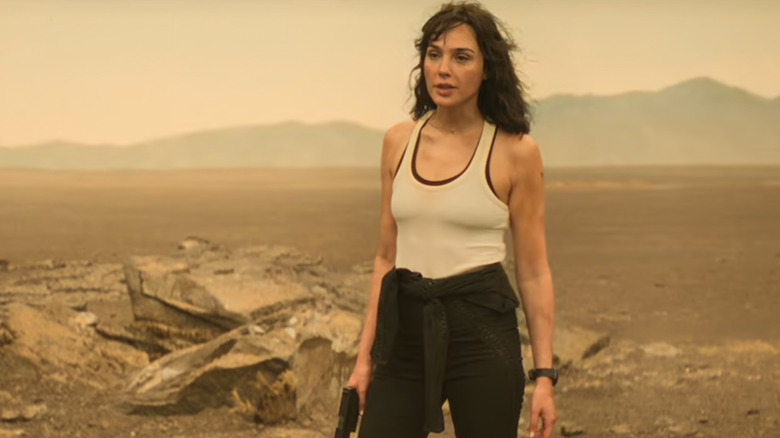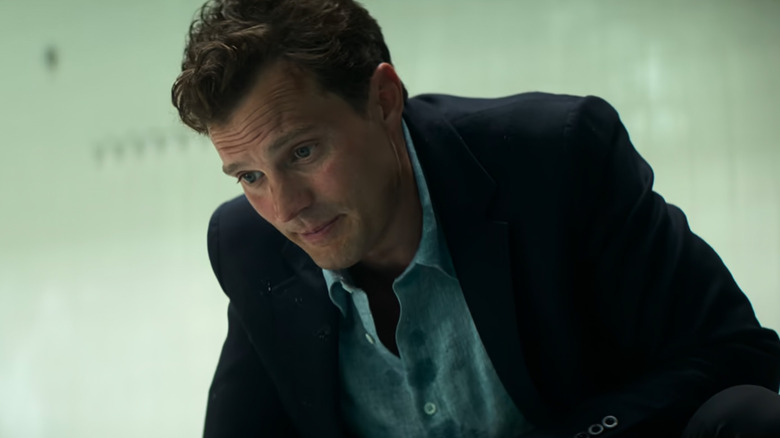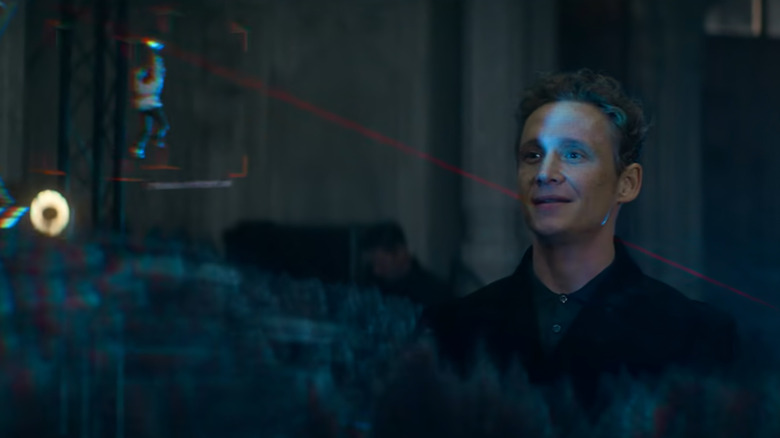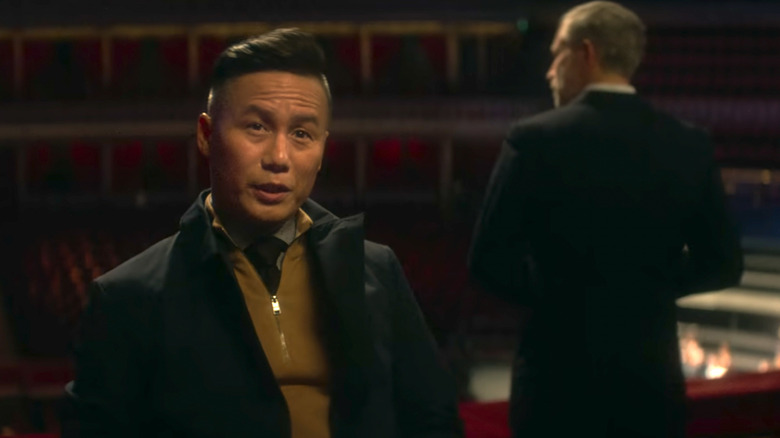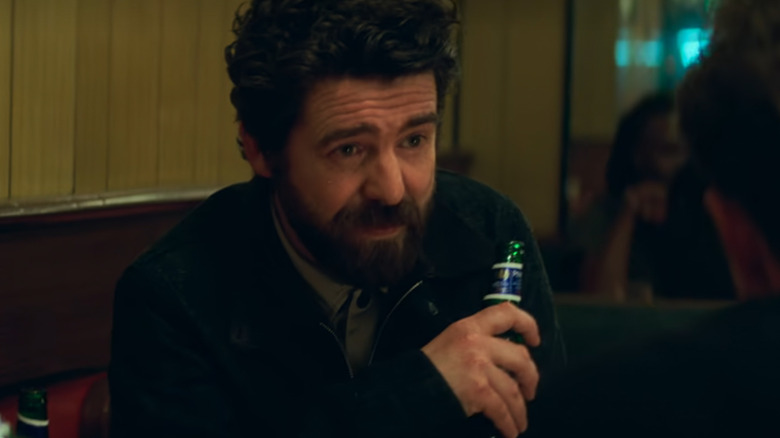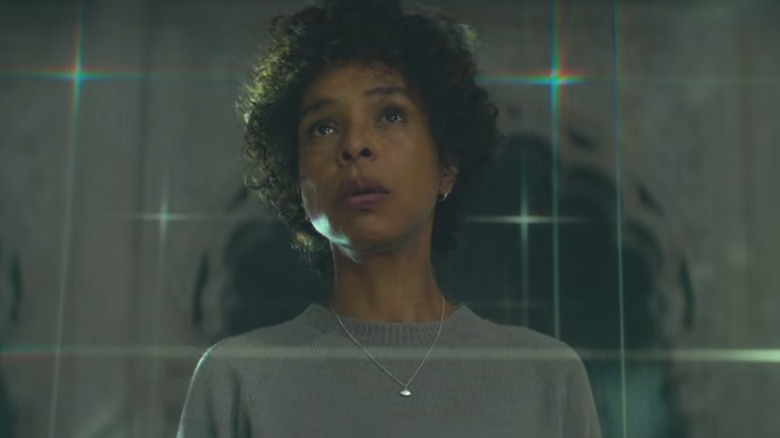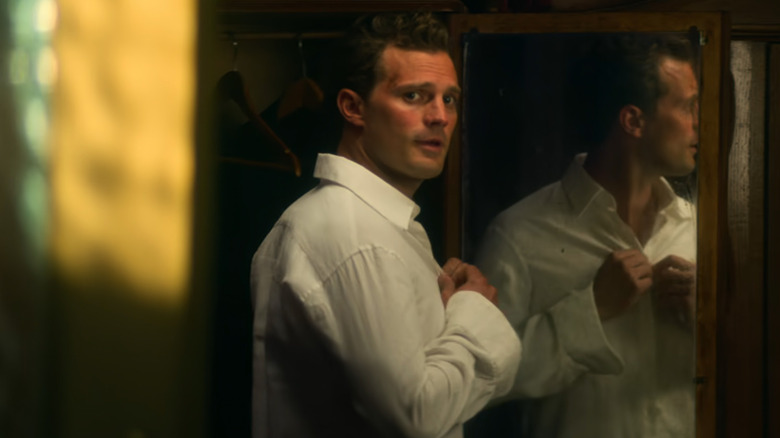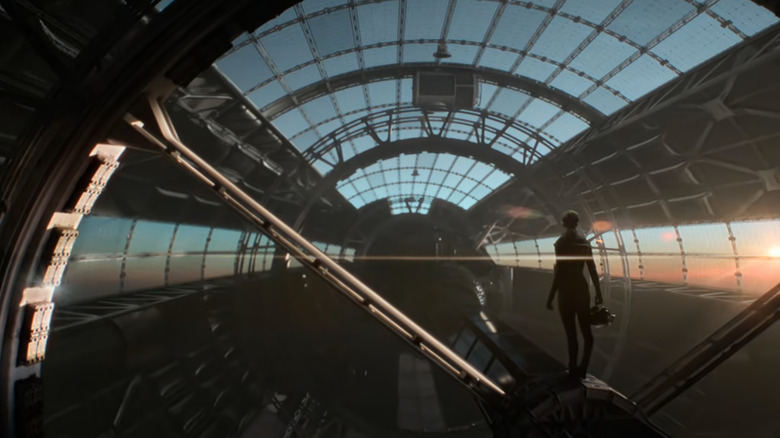Small Details You Missed In Heart Of Stone
Contains spoilers for "Heart of Stone"
Following the release of "Extraction 2" with Chris Hemsworth, Netflix has continued its successful 2023 run of action movies with "Heart of Stone," led by "Wonder Woman" star Gal Gadot. Directed by Tom Harper (Prime Video's "The Aeronauts"), the film introduces audiences to Rachel Stone, an operative for a secret intelligence organization called the Charter. Operating outside of a traditional government hierarchy, the Charter's agents use a sophisticated artificial intelligence apparatus known as the Heart to guide them in peacekeeping efforts around the world.
On their latest mission, led by Stone, the Charter comes into conflict with unknown enemy agents who are trying to take down the Charter and steal the Heart. If they succeed, they will have the means to exert control over entire world governments, posing a threat greater than any the Charter has ever faced.
With a complex plot that includes a number of shocking twists and plenty of stunning reveals, "Heart of Stone" is a spy thriller that will keep you guessing from start to finish. But while you'll have to keep your eye on a carefully unfolding plot, there are plenty of details you may miss. That's why we're here, because we've found more beneath the surface of "Heart of Stone" that deserves a look.
The first action sequence shows of all of Stone's skills
Like any great action movie, "Heart of Stone" opens with its hero in the middle of a dangerous mission. Little do we know, however, that computer expert Rachel Stone isn't even a real MI6 operative, but is working undercover as one for the enigmatic global intelligence agency known as the Charter. In this role, she goes behind the back of her MI6 team and takes on an entire squad of deadly goons without them knowing. But to do it, she'll have to use every trick she knows.
What you might not notice at first is that the opening action sequence has Stone showing off just about every skill she'll need in crucial moments later in the film. Beyond her expert marksmanship, her talent for hacking, and hand-to-hand combat skills, Stone also proves to be a trained motorcycle rider, stealing a bike from a passerby. She also displays her prowess with a parachute when she swipes a snowbound paraglider from a pair of skiers and uses it to jump off a cliff.
These skills all come in handy later, including in a high-flying escape where she's forced to use one parachute to save herself and Keya (Alia Bhatt). Stone also engages in a thrilling bike chase when she's racing to stop Parker (Jamie Dornan) in the film's climax, and gets to flaunt more mid-air moves when she intercepts Parker with a wingsuit in the sky.
Heart of Stone has a decidedly Bond vibe
Spy movies are one of the action genre's oldest staples, so "Heart of Stone" is certainly nothing new. From "Mission: Impossible" to the "Bourne" movies, they've continued to soar in popularity in recent years, too. But "Heart of Stone" seems to be aiming for a certain energy and tone similar to the franchise that defined the format: James Bond. While 007's agency, MI6, is a real-life intelligence organization — far from the more mythical agency known as the Charter in "Heart of Stone" — the Bond version operates much more closely to the one seen in the Gal Gadot film: a shadowy, elite group of agents who boast bleeding edge, and indeed futuristic, technology and gadgets.
The film's striking opening credits sequence, with bold animation and a pop song punctuated by a sultry female vocalist ("Quiet," written and performed by Israeli singer-songwriter Noga Erez), also recalls Bond movies, which are known for similar opening themes and sequences. Even the incidental score, with its emphasis on horns, feels very "Bond."
The agents of the Charter, meanwhile, are also given secretive code designations, but rather than numbers like 007, their designations are the numbers and suits in a deck of playing cards. Clearly not coincidental in its similarities, Netflix — whose competitor Prime Video now owns the rights to Bond after acquiring MGM — may be hoping that "Heart of Stone" can kick off its own rival spy thriller series.
The opening credits foreshadow the movie's biggest action scenes
The Bond-like opening credit sequence is one of the most impressive moments in the entire film, and in addition to paying homage visually to genre classics like "Goldfinger" and "Thunderball," it also pays tribute to the classic spy-thriller trope of previewing the movie's big action sequences. Used frequently in "Mission: Impossible," where clips from the film's climactic action sequences are often spliced into the opening credits, the animated opening credits of "Heart of Stone" subtly foreshadow some of the film's biggest moments.
During the opening credits, we are given glimpses of Stone's motorcycle chase through the snowy mountains as she's pursued by a deadly assassin, as well as a hint of her heartstopping escape off a cliff and into a lagoon. An image of Stone falling from the sky foretells her fall from the Heart blimp, while the image of the A.I.'s computer core is also seen briefly. These details might not mean much on their own, but they are a fun, clever way of setting up the movie that makes a second watch all the more enjoyable.
Heart of Stone has more than one Wonder Woman connection
With superstar Gal Gadot in the title role as Rachel Stone — a tough-as-nails hero out to save the world from diabolical villains — Netflix's "Heart of Stone" has one obvious connection to DC's "Wonder Woman" movies. Stone and Princess Diana of Themyscira also have a lot in common beyond being played by Gadot, from their combat skills to their selfless nature, and even their ability to reach out to an enemy to make the world a better place. Yet the film has one more connection to DC's greatest female hero that you might not have noticed.
A close look at the film's credits reveals that the movie was written and produced by Greg Rucka. Movie buffs may recognize the name for his work on other female-led action movies like Charlize Theron's "The Old Guard" and Kate Beckinsale's "Whiteout," but Rucka is arguably better known for his work in the comic book industry, including a pair of iconic runs on DC's "Wonder Woman."
Alongside artist J.G. Jones, Rucka penned "Wonder Woman: The Hiketeia," where Diana is forced into a showdown with Batman. Not long after, Rucka became the writer on DC's primary "Wonder Woman" title, on which he remained for several years, which became famous for its legendary covers by artist Adam Hughes.
Jamie Dornan plays a role he doesn't want
Agent Parker, played by British actor Jamie Dornan — best known for his role as Christian Grey in "Fifty Shades of Grey" — is first introduced as a highly trained MI6 agent. Debonair, charming, and downright dashing, he's seen cradling a glass of whiskey and seems to draw the eyes of the ladies. As a character, he clearly has a lot in common with James Bond, and that seems like no coincidence given the overt Bond vibes of the film. But what is interesting about it is that Bond is a role that Dornan himself says he doesn't really want.
For months, Dornan's name has surfaced as a possibility for the role of Bond, to replace Daniel Craig, who concluded his run as 007 in 2021's "No Time to Die." Just days before "Heart of Stone" was released, though, Dornan addressed the rumors and was quick to dispel any suggestions that he was going to snag the part.
"I love doing it," Dornan said about his role as Parker in "Heart of Stone" during an interview with Radio Times. "But you know –- I've said this sort of thing before -– I wouldn't want to do that movie after movie after movie ... I wouldn't ever want to be an action star. I have no interest in that." Though some feel he's playing coy, it's also possible that Parker satisfied any itch he may have had to play a super-spy.
The Heart isn't as perfect as they want you to believe
At the heart of "Heart of Stone" is the Heart, a shockingly advanced artificial intelligence. It's the very core of the Charter, the worldwide agency that few know exists, and those that do believe is merely a legend. Thanks to its highly secretive quantum computing code, the Heart is able to hack into any computer system in the world. With that ability, it has access to untold gigaquads of information that allow it to serve as a predictive model of everything from an individual's behavior to the collapse of nations.
With astonishing accuracy, it's said, the Heart helps guide the Charter in its mission to make the world a better place. In the final moments of the film, though, Rachel Stone reveals that they can't rely on it alone, because it's not as perfect as it's made out to be. And for those paying attention, this is actually alluded to very early in the film.
During Stone's daring first mission in the mountains, the Heart predicts that there is no way for her to accomplish her task after her parachute is stuck on a power line. That's because, Stone says, the Heart lacks human creativity, just as she uses the chute's straps to glide down the wire. It's a brief moment, but one that underscores that the A.I.'s supposedly perfect algorithms have some pretty obvious weaknesses, and human assets like Stone are more important than ever.
The Charter only has 52 agents in the field
When we first meet Rachel Stone, we are led to believe that she's a meek computer expert and MI6 agent with no experience in the field. But almost immediately we realize that she's actually one of the most dangerous and elite secret agents in the world and a member of the Charter. We also learn that in that organization she's not just Agent Rachel Stone, but also goes by the code name Nine of Hearts.
As we are told more about the Charter, we learn that the group is based on a deck of standard playing cards, with four suits — Diamonds, Hearts, Spades, and Clubs — each commanding a different arm of the organization. Each suit has its own group of agents, but what you might not realize is that if the Charter's agents are all named after cards in a deck, it means there can only be 52 total agents. That includes the King of each suit, who operates as the leader of each group; Stone's King — the King of Hearts — is played by British actress Sophia Okonedo.
We also meet administrative agent Jack — the man who operates the Heart — who the closing credits reveal is actually the Jack of Hearts. Oddly, though, the format of playing cards seriously limits the number of agents they can have. This causes a problem when Stone recruits Keya at the end of the film — and she's forced to name her "Joker."
The agents' musical choices reflect their personalities
In the first act, audiences are introduced to a team of dedicated MI6 agents. The British super-spies are led by agent Parker (Jamie Dornan), whose team includes point man Bailey (Paul Ready) and cold-blooded sharpshooter Yang (Jing Lusi), alongside Gadot's computer expert Rachel Stone. During their mission, the friendly team members are frequently seen bickering over what music they're listening to, and it seems the filmmakers were careful to select choices for each one that matched up with their personality.
The fun-loving, wise-cracking Bailey is a big fan of '80s music: He's heard playing the hit 1987 Fleetwood Mac tune "Everywhere" from their album "Tango in the Night," an appropriately playful selection. When Yang has her say, though, the tone shifts to Lizzo's "Juice," a vibrant, fast-paced modern pop song with sass, which perfectly fits her strong, gung-ho attitude and exuberant energy, even when she's blowing away the baddies.
Parker, meanwhile — a straight-laced, suave man of mystery — prefers something more "cultured" and old-fashioned. His song of choice is "Fado Portugues," a 1970 song from fado artist Amalia Rodrigues. Fado music is a lesser-known genre known for its classical guitar and viola and can trace its origins back to the early 19th century.
Each of the Charter's four suits represents a different world region
While we get to meet Agent Rachel Stone of the Charter — who goes by the code name Nine of Hearts — and other members of her team, we are also introduced to the four leaders of the different "suits" who run the Charter: The King of Hearts (Sophie Okonedo), the King of Clubs (B.D. Wong), the King of Diamonds (Glenn Close) and the King of Spades (Mark Ivanar). What audiences may not realize, however, is a detail hidden in the Kings that isn't readily apparent.
Take a closer listen to the four Kings, and one quickly realizes that based on their background, each suit represents a different global superpower. Glenn Close's King of Diamonds is the United States, Wong's King of Clubs is China, Ivanar's King of Spades is Russia, and Okonedo's King of Hearts is the United Kingdom. Though they are friendly allies, it doesn't mean that they don't have their issues with one another, as there is clearly some friction between them during their brief meeting in the film. Sadly, the King of Clubs is killed in an trap set by Parker, so if there is a sequel, we may be in for a new playing card replacement.
Parker's music choice is a clue to his betrayal
We've already talked about how the music chosen by each member of the MI6 team belies a clue as to their personality. But when it comes to Parker — who is eventually revealed as the true villain of the film — his own choice of music could actually be seen as a hint that he's really the hidden mastermind and the very enemy that the Charter is searching for.
Written by Amalia Rodrigues, "Fado Portugues" is taken from her album of the same name. The fado musical genre, meanwhile, hails largely from Lisbon, Portugal in the 1820s. Those who have seen "Heart of Stone" will already understand the significance of that location, because it's where the elusive Keya — the young woman allied with Parker in his scheme to steal the Heart — is located when the Charter tracks her down. In fact, they're in Lisbon when he plays the song, suggesting he may have picked it to fit in. But his familiarity with it may be a clue that he's listened to it before.
We're not sure if the choice of song is a sly hint by the filmmakers to plant the seed for Parker's betrayal, but it certainly seems suspicious in hindsight.
The Heart is an environmentalist machine
When we're first introduced to the Heart — the mysterious but highly advanced artificial intelligence that conducts all mission analysis for the Charter — we have no idea how it works. Presumably, it can be run from a computer in the Charter's headquarters, but when the evil agent Parker reveals his intention to steal the Heart, we learn its secret: The Heart is operated from a skybound, zeppelin-like vessel that makes it difficult for anyone to reach.
Going against orders, Agent Stone uses an aerial wingsuit to get aboard the zeppelin and stop Parker when he tries to break in and steal the Heart's core. When she's on the surface of the vessel, we see what appears to be an outer shell almost entirely composed of solar panels.
More than just a means to save electricity and help the environment, the Heart's use of solar panels on its outer surface also suggests that it never needs to land. The constant supply of sunlight — from above the clouds — should allow the operation of the zeppelin continuously and without end, never requiring a recharge of battery cells or a refueling of any kind, even if it isn't quite impenetrable.
